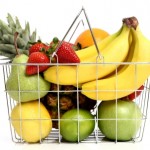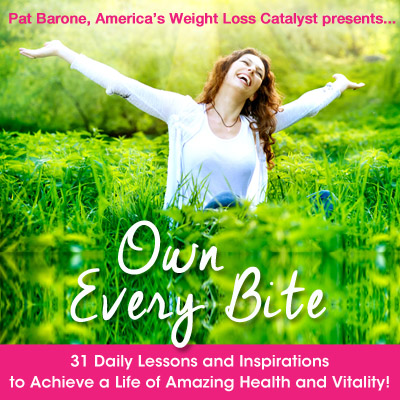In response to my last post, hotmother asked me to address the cost of healthy food.
It doesn’t have to cost more. In fact, most of my clients find they spend a lot less once they start to eat healthy food. Not only does real food have more nutrients, it fills you up faster and keeps you satisfied longer. This is especially true when you put the emphasis on lean or low-fat protein in your diet.
For example, the next time you tuck into a large pasta dish with a side of garlic bread, notice how quickly you’re hungry again. Add dessert to that meal and you’ll be hungry before you get home from the Olive Garden!
Most processed snack foods are actually simple carbs layered with a lot of fat and offer little nutrition and lots of calories. Chips, crackers, snack bars, cookies, cakes, etc. will “pad” your grocery bill and your waist. Have you ever noticed that an entire bag of chips doesn’t seem to fill the stomach, but an apple will satisfy hunger at less cost and a whole lot fewer calories?
I’ve seen many a client lose weight by addressing the protein imbalance in their diet. They find two eggs will give them energy until noon whereas a big serving of cereal with fruit and toast had them gnawing at the computer mouse at 10 a.m.!
So, don’t assume it will cost more to eat fresh, healthy food.
In fact, the biggest money saver…
is avoiding restaurants. Forget the other big assumption, that it saves time to eat out or order in. I actually timed how long it took me to get my family to decide what to order at a Chinese restaurant, call the order in, go pick it up or wait for delivery, etc. against whipping up something simple and nutritious at home and there was no comparison! At home, we were eating in 15-20 minutes. Take out, even with delivery, is usually a 45-minute ordeal.
If you’re steering your family towards healthier eating, here are a few tips to keep the budget in line:
1. Buy these items in bulk: lean meats, fish, poultry, whole grain pastas, brown rice and whole grain flour to make your own baked items, when you do want to include them in your diet. Divide larger bulk packages of meats into smaller, meal-size units before freezing.
2. Get as close to whole food as you can. Real oatmeal, when bought in bulk from a co-op or health food store, is cheaper than the pre-packaged, heavily sugared stuff.
3. Follow this hierarchy when using food: fresh first, then frozen, then canned. Buying in season is the cheapest way to buy fresh, and you’ll save more if you buy from farmers’ markets. (Buying local has less impact on the environment too.)
In the off-season, you can use frozen or combine frozen and canned together. Look for fresh frozen without added sauces. You can season and spice as you like. Some vegetables are better fresh, like broccoli. Others don’t lose much in the canning process, like beans or corn. Add a can of spicy beans to rice or pasta for both flavor and protein. Or use fresh, frozen and canned vegetables in casseroles or stir-frys: combine frozen carrots and onions, a can of corn or green beans, and fresh broccoli.
Citrus and bananas taste better fresh but you can add canned or frozen chunks of pineapple and pears (packed in 100% fruit juice) or berries to make a fruit salad that’s full of flavor and nutrients.
In the same way, canned tuna or salmon can boost the protein of a casserole or pasta dish with less cost than fresh fish.
4. Most stores rotate the price of meat. They’ll feature sales and lower prices on chicken when they get a new shipment and it’s plentiful. A few weeks later, they might slash prices on beef. Tune into this and buy in ample portions when it’s at its lowest price. Know the average prices so you don’t overpay on impulse. Many items have an “off season” like turkey and hams.
5. Avoid processed, packaged or manufactured food. This includes hamburger helpers and similar items that add a lot of chemical preservatives and very little nutrition. You can extend smaller amounts of protein with your own bulk-bought pastas, rice and vegetables and you’ll avoid the sodium/MSG haze afterwards.
6. One of the easiest ways to slash the food cost is to avoid eating out, especially at lunch. I’ve seen many of my coaching clients “find” an extra $200-300 a month to pay off debt by simply bringing lunch to work, slashing “pizza nights” and throwing out the Chinese takeout number. Prepare a week’s worth of snacks or lunch side servings by rinsing and cutting vegetables into serving-size bags. If you’re serving a dinner item you enjoy, make an extra serving and put the leftovers into your lunch bag or freeze it for later use.
7. When shopping, know exactly how you’re going to use the food you purchase. Don’t buy anything that isn’t on sale or extremely high in nutrition.
8. Bulk stores like Costco and Sam’s Club are seductive but, if you don’t use the food, you’re wasting it. Make sure you’re actually saving money by using their membership. Many people buy in bulk, then get tired of the food or don’t use the food in time, and throw it away. I recently bought larger packages of romaine lettuce and red peppers at Costco, only to have them inedible several days later – wilted and shrunken. Saving money (and food) means buying smaller, exact amounts for immediate use.
9. Eating smaller portions of nutrient-dense food is actually smarter in many ways. You can train your body and stomach to appreciate smaller amounts of food and you can get MORE nutrition AND flavor. With empty calorie foods, you can eat a lot and still be hungry. In fact, most high carb snack foods cause the cravings that lead to binges and overeating later.
10. Use soon-to-expire vegetables and chicken bones to make broths for soups and sauces.
Changing dietary style isn’t an overnight decision and it doesn’t happen instantly. And there’s also no perfect way to do it. Simply substituting one fresh item a day for a processed snack is a great beginning.
Every change counts!
I started my weight loss effort in 1996 by simply adding a green salad to dinner every night, and look where it led me! Making changes that you can sustain for life is the way to lower your weight and boost your health permanently.
There is a saying that goes: “pay now or pay more later.” When it comes to your health, every effort you make now will save you much more than money over the span of your lifetime. It’ll also boost your health and have positive impact on the quality of the longer life you’re building.
What’s the cost of healthy eating? Do you really want to find out the cost of NOT eating for health?
This blog was featured on “Prevention Not Prescriptions!” Find out more and share information for “Prevention Not Prescriptions” at The Kathleen Show here.







Pat I totally agree with you. I spend twice the money when I am not eating healthy. I buy on a whim depending on my cravings and the next thing I know I have a $200 baket full of junk! (note I have not done that in about 6 months)
Planning is the key for me and that goes hand in hand with buying smaller ready to use amounts.
The money saved overall when you consider your health and everything else is huge!
I got a message on my blog,a few days ago, from someone who doesn’t drink water because ‘tap is gross and bottled is expensive.’ The fact is that if you’re looking for an excuse, you’ll find one.
Sodas cost 4 to 5 times more than buying a jug of water. And the truth is that healthy living would be worth the cost even if it was more.
It did cost more initially because I bought spices and herbs that I had not used previously, but the foods I eat are also richer…more satisfying…and fun to enjoy.
It takes more effort to eat well, but the results of that effort are completely and utterly worth it!
Kenz, what you said is so true… and you have the money cost of the soda and the health cost, which is huge in the long-term picture.
There’s also a difference between investment and cost. I consider focusing on healthy food (and water and exercise!) an investment in my future. Overeating and “just getting through stress with the help of food” may seem cheaper at the moment, but they are not. The price is simply paid later, and more painfully.
The same applies when my clients invest in coaching. They’re able to see things long-term and see the path they’ve created in the past isn’t taking them where they want to go. They decide to create new futures for themselves. Between what they learn about the actual physiological components of weight loss (which very few people understand, much less teach) and learning to think and act differently about food, their bodies and their future, they are actually taking the fast track to happier lives. With an investment, the payoff goes on forever. The same goes for a healthy weight. Learn and grow your way into it now, make it a way of life, and you can hum along while everyone else is stumbling and suffering through 50 diets.
Thanks so much for the great comments, everyone!
I really enjoyed your shopping tips! It’s going to save me a large sum of money as I am guilty of always eating out for lunch, only to cry at the ridiculous amount of money I’ve spent at the end of each month. I am a frequent shopper of Costco and I buy large cuts of beef. I like what you said about dividing your food into smaller portions to cook throughout the week. I’m definitely going to try that with my meats.
Your tips are so helpful! Thank you so much.
I totally agree about the cost of healthy food vs the rest.
I do shop at Costco for veggies though. I just can’t bring myself to pay twice as much..for example: Three hearts of Romaine lettuce are around $3.99(not on sale) while 6 big ones sell for $4.99 at Costco. I also shop at other bulk veggy stores. What I do to prevent waste is COOK the excess if I see it isn’t being eaten.
You can’t imagine how delicious sauteed Romaine lettuce is. I can eat 2 heads at once when I cook it, it is also so low calorie depending on the flavoring/seasoning I choose. I also love quickly broiling excess red peppers then puree-ing it with the skin and either adding hot chilis or garlic or whatever I want from Cajun to Oriental. Great with anything!!!!! Fish, Chicken, Brown Rice mixed in with apple cider vinegar to make a salad dressing.
Try chopping up all your less than perfect veggies and making a veggy soup, lettuce included.
Oh for sure…healthy eating saves you in every way, including your wallet.
Great point about cooking up the veggies when they’re edging towards their last days! I love that. Never imagined cooking romaine but we cook spinach so why not? Will try it. As you mentioned on twitter, once cooked, you can freeze the vegetables for sauces or soups later.